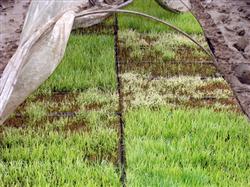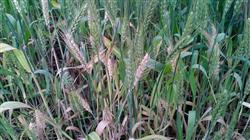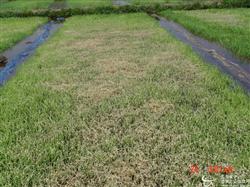Common knowledge of Rice Black-streaked Dwarf Disease in South China

First, the occurrence situation of rice black-streaked dwarf disease was first found in late rice in Guangdong Province in 2001. In recent years, the rice area in Vietnam and southern China has expanded rapidly. In 2009, 9 provinces such as Guangxi, Guangdong and Hunan occurred, with an area of 5 million mu, which is expected to exceed 10 million mu in 2010 (there are no accurate statistics yet). In August this year, black-streaked dwarf disease plants were found in Funing, Guangnan, Yanshan and other counties, with a general disease cluster rate of 13.5%. 3000 mu occurred in our county in 2010, with a disease cluster rate of 5% to 10%. The disease is susceptible to rice at all growth stages, with a general loss of 530% of the affected fields, and a particularly serious one will lead to no harvest. Second, the characteristics and symptoms of the disease vary according to the period of infection. The susceptible rice plants at seedling stage were seriously dwarfed (less than 1x3 of normal plant height), could not jointing, and the seriously diseased plants withered and died early; at the early stage of field, the susceptible rice plants obviously dwarfed (about 1 par 2 of normal plant height), and could not bear fruit without heading or neck heading; at jointing stage, the susceptible rice plants were not obviously dwarfed and could heading, but the panicle type was small, the full grain was less and the grain weight was light. The common characteristics of rice plant disease are as follows: (1) the leaves of diseased rice plants are dark green, and uneven wrinkles can be seen on the upper leaves (mostly at the base of leaves); (2) there are anatropous fibrous roots in the aboveground nodes of diseased plants; (3) the branches of high nodes of diseased plants 4. On the surface of the diseased plant, there are tumor-like processes of about 1 mm in size (obvious roughness on the hand), which are arranged longitudinally in the shape of wax dots, milky white in the early stage and brownish black in the later stage; the nodal position of the diseased tumor varies according to the susceptible period, the early susceptible rice plant, the diseased tumor occurs in the inferior node, the later the susceptible period, the higher the nodal position. 5. The root system of the susceptible plant is underdeveloped, the whisker root is few and short, and the root system is yellowish brown in severe cases. Rice black-streaked dwarf disease in southern China is a serious virus disease. In addition to rice, the disease can also infect more than 20 kinds of hosts, such as wheat, corn, sorghum, barnyardgrass, dogtail grass and so on. The virus overwintered mainly on wheat, corn and Gramineae weed disease plants. The migratory pest, white-backed planthopper, was used as an efficient transmission medium (once poisoned, it carried the virus for life). When the white-backed planthopper is harmful to the diseased plant, it will immediately be infected with the virus. when the infected planthopper turns to the healthy plant, it will pass the virus to the healthy plant. Once the healthy plant is infected with the virus, the virus will harm the growing point of the rice, and the rice will stop growing immediately. The whole growth period of rice can be infected, the younger the seedling age is, the more susceptible the disease is, and the shorter the incubation period is; the earlier the disease is, the more serious the disease is, and the greater the yield loss is. 4. the key to the prevention and control of rice black-streaked dwarf disease in southern China is to control the rice planthopper. The prevention and control measures mainly adopt the "pest control and disease control" strategy of "grasping the early stage and the later stage, grasping the seedling field and protecting the field", focusing on protecting the seedling field and the early Honda stage. Early and middle rice before heading, late rice seedling stage and tillering stage, to do a good job of prevention and control before the transmission of white-backed planthopper. At the same time, it is necessary to strengthen fertilizer and water management, balanced fertilization, and improve the resistance of crops. 1. Eliminate Gramineae weeds, rice regenerated seedlings and autogenous seedlings in the field and ditch, so as to reduce the source of poison in the field. 2. Breeding and popularizing insect-resistant and disease-tolerant varieties. 3. To strengthen seedling management, nitrogen fertilizer should not be applied to prevent seedlings from being too green and cause serious damage to rice planthopper. 4. harness rice planthopper, especially at seedling stage and tillering stage. Use 30 grams of 25% aphidione suspension or 50 grams of 25% buprofezin wettable powder and spray 50 kg of water.
- Prev

Control of wheat sheath blight by early application of Thiofuroamide in spring
In recent years, the planting area of direct-seeding rice in northern Jiangsu and other places is relatively large, which leads to the late sowing date of wheat. In order to ensure the yield of late sowing wheat, the seeding amount is often greatly increased. The seed amount per mu of high fields is 20~30 kg. The wheat seedlings in the field grow too densely. With the spring temperature rising, the wheat quickly recovers its growth.
- Next

Diagnosis and control of rice seedling rot
Rice seedling rot is a general term for rotten seeds, rotten buds and dead seedlings caused by pathogen infection or non-pathogen influence. It can be divided into two categories: infectious and non-infectious (physiological). Non-infectious rotten seedlings mainly refer to those caused by adverse environment; infectious rotten seedlings refer to those caused by adverse environment, such as Pythium, Fusarium, etc.
Related
- The first cup of black tea in spring, the flavor and history of tea gardens in Kenya, Africa
- The computer can not only choose potatoes, but also grow tea rice. AI will grow winter oolong tea champion.
- It is not only the inflated tea bitten by insects, but also engraved with the four seasons tea in Beipu.
- The Oriental Beauty Tea Festival in Zhuxian County takes the stage at the weekend to experience the plus-size feast of oil tea.
- & quot; Oriental Beauty Tea & Exploration of Emei in Hsinchu, the hometown of quot;
- The new variety of strawberry "Tainong 1" dessert is the first choice with mellow aroma. Crimson gorgeous
- History of Tea in Taiwan: from Wild Inner Mountain to Export Tea Garden
- Two types of Taiwan Oriental Beauty Black Tea won the British three-Star Award for Childhood Tea Xiang Zhang Jiaqi changed from pilot to champion tea maker.
- Banana species and varieties: the planting history of Taiwan Xianren banana and dwarf banana is long, is banana disease resistant?
- Coffee planting Technology: Qianjie Coffee from Seedling to harvesting

